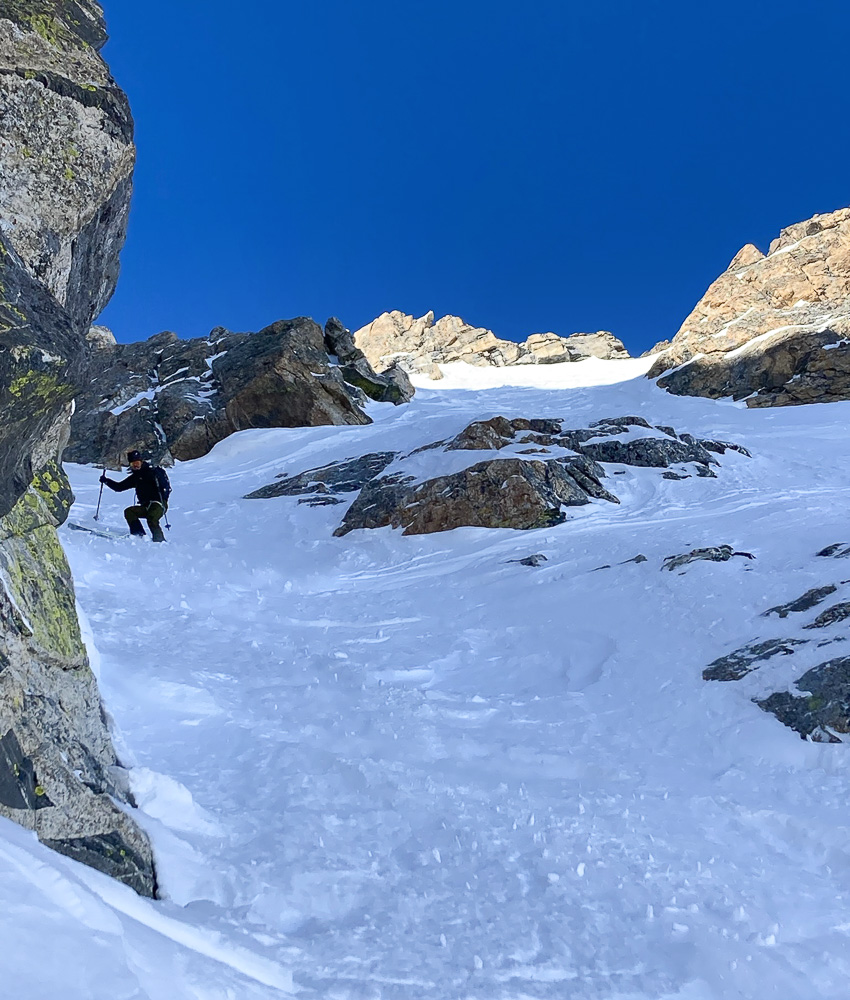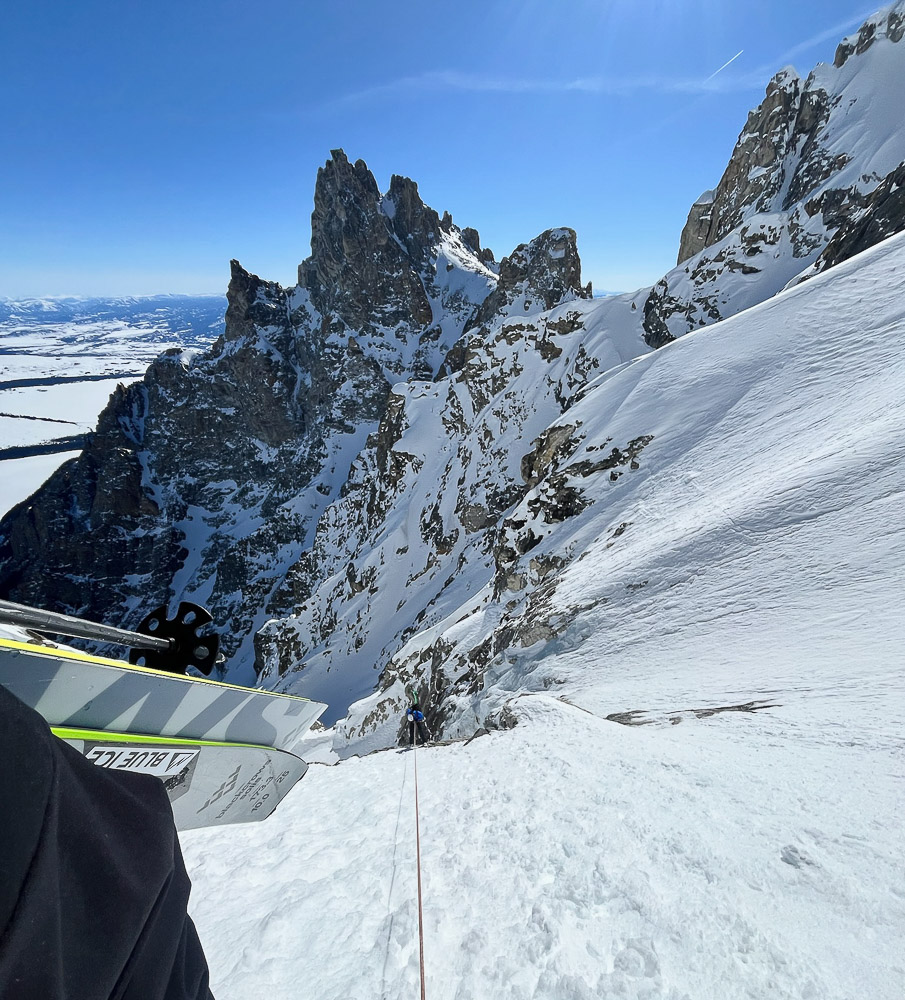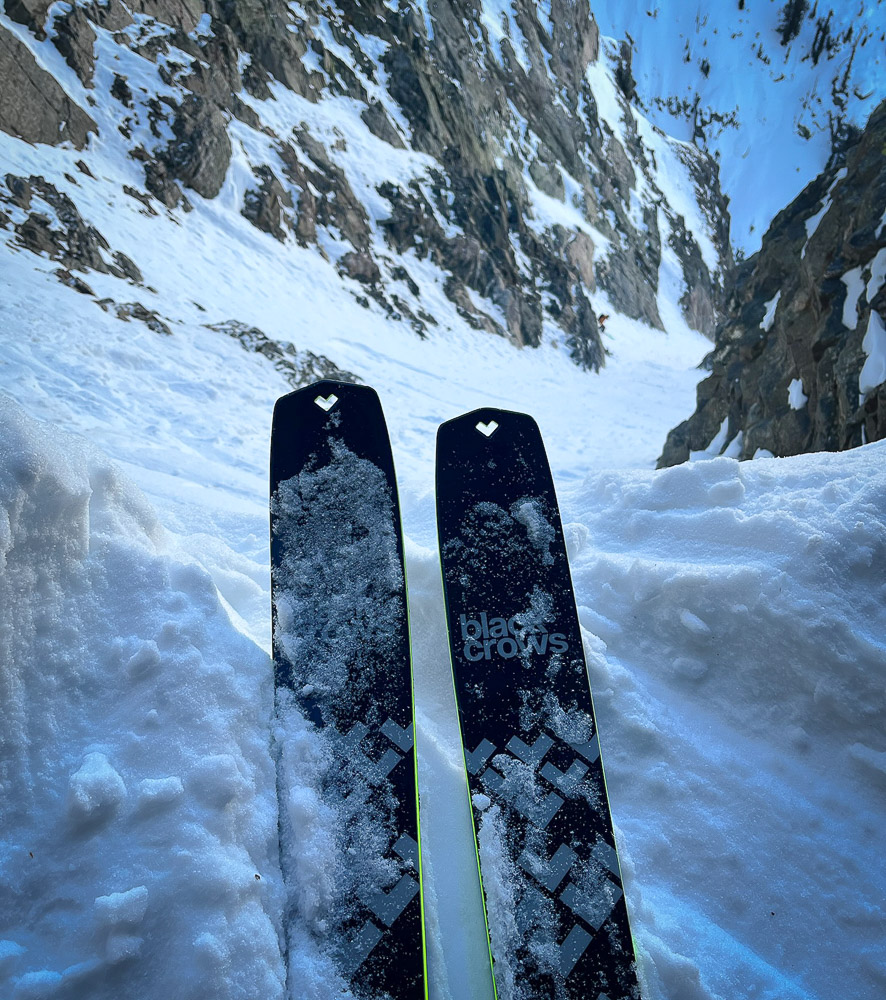Julien Regnier, noted ski shaper at Black Crows, has cooked up something special in the Solis. Our gear editor claims the Solis is appropriate for more skiers than the marketing suggests.
Intro
Where do we start? Black Crows…no longer the newest kid on the block; they are a teenage brand (literally), epitomizing Chamonix ski culture–high style and high function. For the most part, our lane at The High Route is the Freebird line of touring skis, maybe the only skis on the market known more by their colors than names. How many skiers know “the green ski” but look at you with a blank stare when you mention the Navis Freebird? Anyways, we are veering off course here. The Solis is in the Big Mountain line rather than the Freebird series, and I don’t think it’s “the black ski,” but maybe it’s “the steep ski?”

Design Highlights
“Voluntarily ultra specific, this ski is for verticality lovers,“ is the last sentence of the Solis’ marketing blurb. Black Crows designed the Solis as a specialized tool for steep skiing, and some other information out there would reiterate that the Solis is a no-fun, no-frills beast that only does one thing well. My experience was different.
In designing the Solis, Black Crows focused on a few key attributes. First, there’s a long and reliable effective edge. Thisplays out with the long, low rocker profile, subtle tip/tail taper, stiff flex throughout, and titanal plate underfoot. Second is a predictable character in steep skiing turns; a straight sidecut, minimal camber, and the subtle tail upturn contribute here. On paper, we are looking at a ski that may be described as “drifty“ without the tendency to hook up into a carved turn but rather slide and drift down the fall line.
Oversteering is often an issue in steep terrain using skis with tighter sidecuts and wide/tapered tips; they want to actively pull you across the fall line and into the next turn. These design attributes also load up the camber on many of these skis into what becomes a quick and active maneuver of linking arced turns, a fun and rewarding feeling in the appropriate terrain, potentially scary or insecure feeling in very steep terrain where we are usually going for more of a controlled and “skidded” turn. The skidded turn is the Solis’ specialty.
Keeping in line with this specific design, the Solis is intended to be skied short—I opted for the 173.3 cm length, with the other option being 180 cm. 173 is more or less in line with my preference for skis that have filled a similar niche of steep/high mountain skiing, such as the Blizzard Zero G 105 that I have in a 172 cm.
From a construction perspective, the Solis is about what we should expect from a 1600-1700g ski these days. Paulownia and Poplar make up the wood core, a full sidewall, titanal underfoot, tip edge, and a plastic tail protector, constitute a ski ready to handle the abuse of high mountain skiing. The topsheets and bases suffered some chips and scratches, and they seem a bit more fragile than the most durable options out there (Moment comes to mind for durability), but this is mostlycosmetic, and overall the durability and build quality are better than adequate.
The recommended mount point is -9 cm, a nice middle of the road position for a pretty directional shape. I bumped up to -8 cm, a little more in line with my Zero G 105s that I like at the -7.5 point.
Circling back to the first paragraph, I did not find the Solis to be the ultra-specific, all-business, no-fun ski that Black Crows advertises. Rather, I found the Solis loose, stable, and versatile—especially in 3D snow. The shape and profile are pretty similar to some “all mountain chargers“ like the Blizzard Cochise. And similar to these chargers, the Solis was surprisingly good at trucking through bad snow, whether avalanche debris in an apron, tracked out and wind-hammered slopes on Mt Glory, or 3D wind effect in the alpine.


Testing Setup
As I discussed last winter, it was suggested that the Solis be paired with a “solid“ binding to take advantage of the ski’s performance. A lightweight binding with a freeride spacer and wide mount pattern seemed like an appropriate pairing to balance weight and performance, though in hindsight, I don’t think it would be wild to put a race binding on the Solis; they aren’t that special.
I almost exclusively skied the Backland XTD with the Solis, a result of this being an excellent boot/ski pairing and the nuisance of adjusting the Slatnar freeride spacer to different boots. The Solis is probably not the ski for “under-booting,” which I’m generally a fan of—it warrants some shin pressure and precision that is a bit challenging with the lightest boots.
I made a pair of skins with Pomoca plush and some Pomoca Z hooks for a tip attachment using the chevron tip cutout (this works well but likely isn’t quite as secure as the Black Crows skin attachment, which is only available on the precut skins). A normal tip loop would also be fine, but the special attachment is sleek and stylish.
Field Testing
Powder/soft snow
At 100 mm wide x 173 cm long, we aren’t working with much surface area here. That being said, the rockered tips planed to the surface nicely in most powder situations. The Solis rocker profile seems like a real masterpiece in versatility—the mostly flat camber paired with a gradual splaying in the tips delivered here. When blessed with deep, settled powder in a steep couloir, the Solis didn’t feel like it got bogged down between turns, a feeling I’ve often experienced with skinnier or less rockered “steep skiing“ skis like the Blizzard Zero G 95 or 105.
Given my love for reverse camber skis like the 4FRNT Hoji and Heritage Lab BC110, I was thrilled to feel the loose and playful side of the Solis. I could slash and slide to my heart’s content in more moderate terrain.
Crud/Tracked/Variable Snow
As mentioned above, the Solis resembles some of the best “crud” skis on the market. This resemblance delivers stability in 3D crud, which is really impressive, especially given the small overall dimensions. The Solis tracked well and was resistant to deflection. Relative to the Moment Deathwish Tour 104, which also had good performance in 3D snow, the Solis was better able to “truck“ vs. the agility and dampness of the Deathwish—different sensations, both good.
In breakable crusts and other punchy/grabby conditions, the 173 cm length and ample tip rocker were advantageous. The Solis gets a pass on the pass/fail grading system here. The rockered tip does a decent job of surfing above crusts and the generally straight and subtle shape offers few opportunities to get caught up in an unpredictable manner.
One gripe here. In some really heinous 3D snow (especially wet avalanche debris and runneled couloirs), the low, square tip of the Solis was a liability. It seemed to require some active maneuvering to avoid javelining the tip into chunky debris or the opposite wall of a runnel. A bit more tip rise/upturn would be welcome here and suit the overall objective of the skis, given the abundance of runnels and wet debris often encountered when skiing steep runs in the spring.
Firm Snow/Steeps
The category we’ve all been waiting for—the Solis’ main selling/marketing point is its steep skiing capabilities. While I would certainly say it delivers excellent edge hold, is nimble, and doesn’t suffer from oversteering, I would say it’s only marginally better in these categories than something like the first generation Zero G 95.
The added weight over some of the more “traditional” lightweight steep skiing tools is both a blessing and a curse. On one hand, the stability and lack of chatter are welcome. (This is a heavier and more damp construction.) On the other hand, they are less “flickable” than something super light and low swing weight. Thankfully, the Solis has an excellent “pivot” action while making steep turns that feel plenty quick and agile, similar to the aforementioned lighter mountaineering skis.
Resort Skiing/Groomers
The combination of small size and long turn radius make the Solis pretty “meh” inbounds, especially on groomers. The pivoting and sliding that works so well in steep and technical terrain doesn’t translate to great fun in 2D resort snow where laying trenches and carving is the name of the game. I could see the 180 cm version being a decent option for soft chop in bounds, but I can’t think of a good reason to break out the Solis in bounds, whether for touring up or riding lifts.

Conclusion
Every time I look at the Solis—especially its rocker profile—it draws my attention; it’s an aesthetic that seems just right. This has led me down a bit of a rabbit hole. Who else makes a ski with such a pleasing, ample, yet gradual rocker profile, mostly flat camber, and a long turn radius?
I am looking forward to seeing how the Down CD104L, Heritage Lab BC100, and 4FRNT Nevar compare as skis that have caught my eye as Solis competitors. Long story short, I’m seeking similar skis because the Solis recipe is excellent, and I want to see what else might provide something similar.
My overwhelming conclusion after a season of skiing the Solis (a lot) is that it is probably appropriate for many more skiers than the marketing suggests. While it thrives in steeper and more challenging environments, it doesn’t need to be that steep or technical to appreciate the nimble, loose character of the Solis. I think the Solis could pair well in a quiver with a reverse camber powder ski like the 4FRNT Hoji or similar, as it preserves many of the fun characteristics of a ski like the Hoji but in a much more “businesslike” performance package.
Specs
Available lengths (cm): 173.3 [tested], 180
Weight: 1746g (verified)
Dimensions (mm): 125-100-108
Turn radius (m): 25
Core: Paulownia/Poplar
Build Comments: Full sidewall, titanal underfoot
Shape: Straight sidecut, long and low tip rocker, minimal camber, micro twin tip tail
Recommended Mount Point (cm from center): -9cm (tested at -8)
Drill size: 4.1x9mm
Similar Models: Down Skis Countdown 104, Armada Declivity 102, Heritage Lab BC100
Price: $1199.00






Leave a Reply
You must be logged in to post a comment.